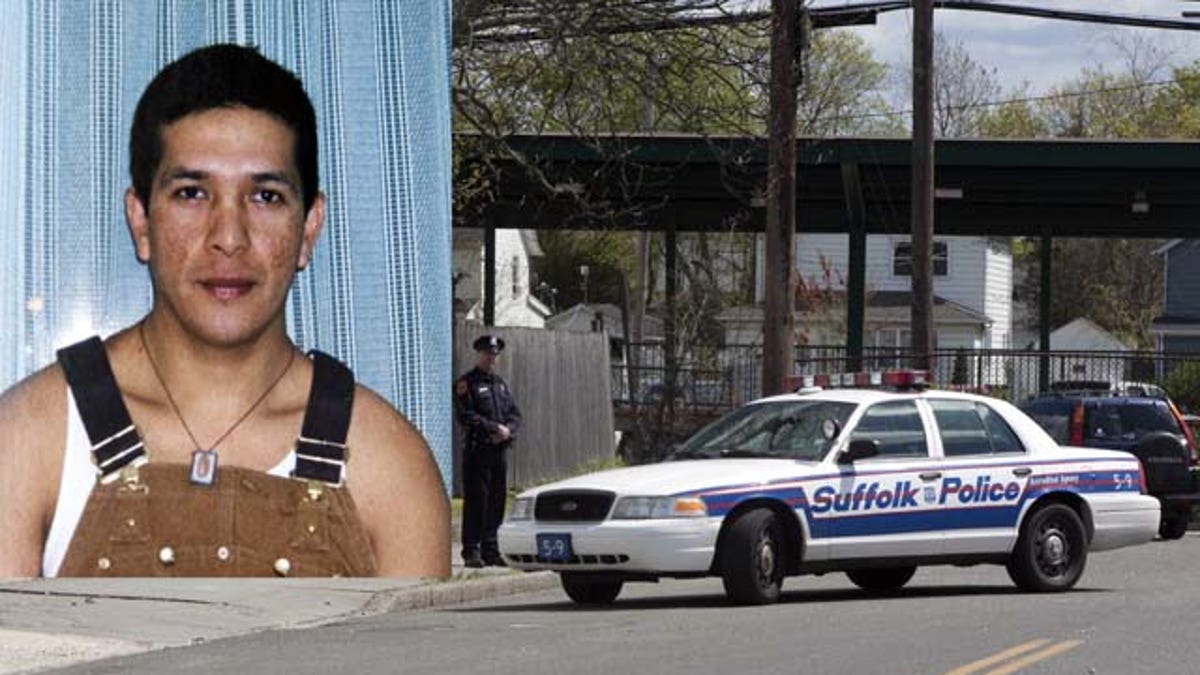
EEUU-JUSTICIA:SHM09 - PATCHOGUE (NY, EEUU), 19/04/2010.- Agentes de la policÃa del condado de Suffolk vigilan hoy, lunes 19 de abril de 2010, el lugar donde fue asesinado el inmigrante ecuatoriano Marcelo Lucero hace un año y medio en la localidad de Patchogue, NY (EEUU), para evitar que haya altercados después de que un jurado popular hallara culpable de homicidio a Jeffrey Conroy, único acusado por la muerte. Siete jóvenes, entre ellos Conroy, fueron arrestados en relación con la muerte de Lucero, que el pasado lunes hubiese cumplido 39 años, pero sólo al citado, de 19 años, se le abrieron cargos por el asesinato. EFE/Miguel Rajmil (Newscom TagID: efespfive570370) [Photo via Newscom]
On the surface, the healing process between Latino immigrants and the Suffolk County Police Department on Long Island has begun.
The police department, for its part, has launched countless initiatives in the last two years to foster trust with skeptical Latinos. Immigrants, advocates say, have crept out of the shadows to report crimes.
The two sides have even gotten together for friendly sporting events.
But some say the efforts, however earnest, are façades that mask what is still an uneasy relationship, one that reached a deadly climax with the 2008 murder of Marcelo Lucero. Suffolk County is still simmering, they say, and can easily boil over again.
“My fear is that once it’s quiet around here and people begin to feel safe, that there’s still a lack of dialogue,” said Rev. Dwight Lee Wolter, pastor of the Congregational Church of Patchogue, the town in which Lucero was killed.
“It’s still here,” he added, referring to the tension that led to the killing. “That’s still the powder keg that can make things worse.”
Lucero, a 37-year-old Ecuadorian immigrant, was beaten and stabbed by Conroy and a gang of mostly white teens who had been accosting Latinos for sport. The brutal crime sent shockwaves that reverberated well beyond Suffolk, and turned New York’s easternmost county into a ground zero of sorts for hate crimes.
The Southern Poverty Law Center issued a report that condemned its police department and elected officials, including County Executive Steve Levy, whose anti-immigrant rhetoric was roundly criticized for creating a toxic environment. Levy’s office declined repeated attempts for comment.
The U.S. Department of Justice, meanwhile, launched an investigation in September 2009 to look into allegations of discriminatory policing and, among other things, failure to investigate alleged hate crimes. The probe is still active, a spokeswoman said.
But Deputy Inspector Christopher Bergold, of the Suffolk County Office of the Police Commissioner, said the department has gone to great lengths to improve communication with immigrants. It has given its officers extensive training on hate crimes and cultural awareness, deployed Spanish-speaking liaisons to each of its seven precincts, and appointed two commanding officers of Hispanic descent to the 5th Precinct, which oversees Patchogue.
“Through the Lucero incident, we came to learn that a segment of the community felt isolated from the police department,” said Bergold in a phone interview. “We’ve used this as an opportunity to reach to the community. Concerns were brought to our attention, and we responded.”
The number of hate crimes in the county have recently declined, Bergold said. In 2007 and 2008, there were 79 and 57 such reports, respectively; in 2009, there were 75, but only 34 through September 30, he said.
Suffolk is ramping up its effort to recruit Hispanic officers, too. It has a $200,000 budget for diversity recruitment, six full-time officers, and is offering a Spanish-speaking police officer exam, Bergold said.
Suffolk County’s police force is 7.5 percent Latino, Bergold said. The county has more than 212,000 Hispanic residents, about 14 percent of the population, according to the 2009 Census.
Bergold also said that officers and immigrants alike are being reminded of the department’s policy that prohibits officers from inquiring about immigration status, he added.
Still, some immigrant advocates wonder if the message from police brass is filtering down to the rank-and-file cops who engage most with immigrants.
“You don’t have to go to Arizona to have profiling,” said Sister Margaret Smyth, director of the Northfork Spanish Ministry in Riverhead. “You just have to go to certain towns in Long Island to see that going on.”
Despite that criticism, Smyth commended the department’s efforts, saying she’s seeing far more immigrants willing to report crimes. But Rev. Allan Ramírez of Brookville Reformed Church, who works with immigrants in Suffolk and neighboring Nassau County, said the department’s efforts are at best ineffective and at worst a public relations ploy.
“When I talk to the average Latino immigrant, they tell me that nothing has changed,” he said. “They still live in fear. They still feel that they have to live in the shadows.”
Rev. Wolter, however, said for true healing to begin, there have to be open lines of communication going both ways. He said, for example, that when he pushed for the immigrant community to embrace and forgive Conroy, he was met with stiff resistance.
“I just fail to see the unity,” he said. “Everybody deserves a seat at the table of justice, and people are not willing to do that. “
Follow us on twitter.com/foxnewslatino
Like us at facebook.com/foxnewslatino
